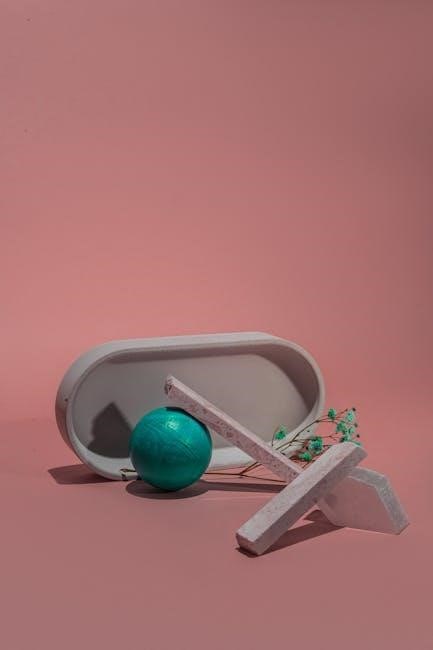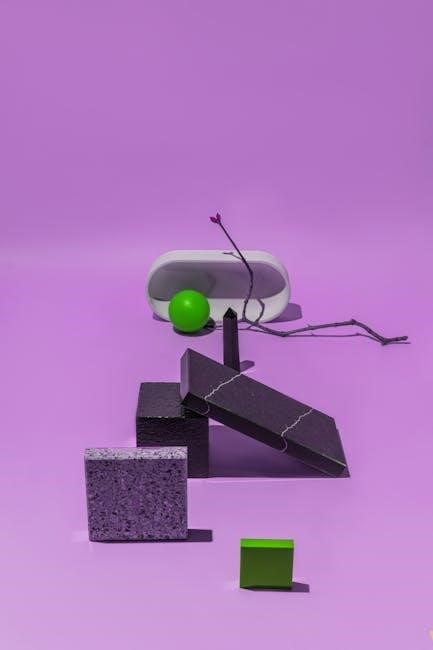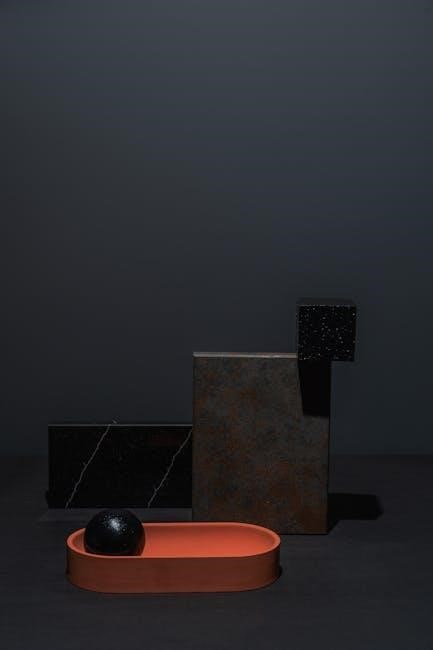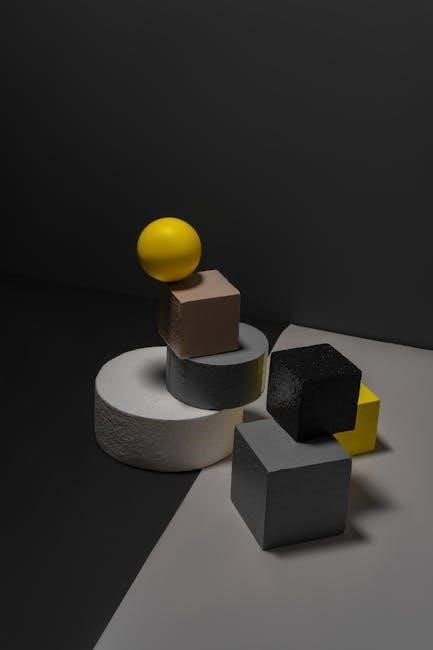
volume of composite figures worksheet with answers pdf
Composite figures are solids formed by combining two or more 3D shapes․ Worksheets with answers provide practice in calculating their volumes, enhancing problem-solving skills and understanding․
1․1 Definition and Importance
Composite figures are three-dimensional solids formed by combining two or more basic geometric shapes, such as prisms, pyramids, cylinders, and cones․ Understanding these figures is crucial in geometry as they appear in real-world applications like architecture and engineering․ Worksheets with answers provide structured practice, helping students master volume calculations․ These resources are essential for building foundational skills, as they offer clear examples and step-by-step solutions, ensuring learners grasp how to break down complex shapes into manageable parts for accurate volume determination․
1․2 Brief Overview of Volume Calculation
Calculating the volume of composite figures involves breaking down complex shapes into simpler, recognizable 3D components like prisms, cylinders, or cones․ By estimating with unit cubes or applying standard volume formulas, students can sum the volumes of individual parts․ Worksheets with answers guide learners through this process, offering step-by-step examples and solutions․ This method enhances understanding and problem-solving skills, ensuring accuracy in determining the total volume of compound solids․

Understanding Composite Figures
Composite figures are complex solids formed by combining simpler 3D shapes․ Analyzing these figures requires identifying and calculating the volume of each individual component separately․
2․1 Common 3D Shapes in Composite Figures
Composite figures often consist of prisms, pyramids, spheres, hemispheres, cylinders, and cones․ These shapes are fundamental in creating complex solids․ Prisms and pyramids are polyhedral, while spheres, hemispheres, cylinders, and cones are curved․ Understanding their individual volumes is crucial for calculating the total volume of composite figures․ Worksheets often feature these shapes, providing practice in identifying and calculating their dimensions․ Real-world examples, like bird feeders, frequently involve these shapes, making them essential for problem-solving and practical applications․
2․2 Breaking Down Complex Shapes
Breaking down complex shapes into simpler components is essential for calculating volumes․ Composite figures can be divided into prisms, pyramids, spheres, or cylinders․ Worksheets often include labeled diagrams to guide students in identifying these individual shapes․ By separating the figure, students can calculate the volume of each part and sum them up․ This method enhances understanding and problem-solving skills, especially in real-world applications like estimating bird feeder capacities or architectural designs․

Calculating the Volume of Composite Figures
Calculating the volume involves breaking down complex shapes into simpler components․ Worksheets guide students through step-by-step approaches, ensuring accurate volume determination for each part before summing them up․
3․1 Step-by-Step Approach
A step-by-step approach to calculating the volume of composite figures involves breaking down complex shapes into simpler, recognizable components like prisms, pyramids, or cylinders․ Worksheets guide students to identify these individual shapes, calculate their volumes separately using formulas, and then sum the results․ Visual aids and labeled diagrams help learners visualize the process, especially for practical examples like bird feeders․ This method ensures accuracy and builds confidence, starting with unit cubes for younger students and progressing to more complex composite solids․
3․2 Breaking Apart Figures
Breaking apart composite figures into simpler shapes is crucial for volume calculation․ Worksheets often include labeled diagrams to help students visualize and identify individual components like prisms, pyramids, or cylinders․ By dissecting complex solids, learners can apply known volume formulas to each part․ This method enhances problem-solving skills and ensures accuracy, especially for practical examples such as bird feeders or architectural structures․ The process reinforces geometric principles and prepares students for real-world applications in engineering and design․
3․3 Adding Volumes of Individual Shapes
After breaking down a composite figure into simpler shapes, the next step is to calculate the volume of each individual component․ Once the volumes of prisms, cylinders, cones, or other shapes are determined, they are summed to find the total volume of the composite figure․ This method ensures accuracy and simplifies complex calculations․ Worksheets often provide step-by-step examples, allowing students to practice and master the process․ By adding individual volumes, learners develop a deeper understanding of how composite figures function in real-world applications like engineering and architecture․

Real-World Applications
Composite figures are used in designing bird feeders, architectural structures, and engineering projects, where understanding volume is crucial for functionality and material estimation․
4․1 Bird Feeders and Other Practical Examples
Bird feeders often serve as practical examples of composite figures․ For instance, a feeder might combine a hexagonal base with a cylindrical tube․ Calculating the volume helps estimate seed capacity․ A cedar waxwing example illustrates how understanding volume aids in designing functional feeders․ Such real-world applications make learning engaging and relevant, showing how composite figures solve everyday problems․ Worksheets with answers provide hands-on practice, enabling students to apply mathematical concepts to tangible scenarios․
4․2 Architectural and Engineering Uses
Composite figures are essential in architecture and engineering for designing complex structures․ Buildings, bridges, and monuments often combine shapes like domes (hemispheres) and columns (cylinders)․ Calculating volumes helps estimate material needs and structural integrity․ For example, a stadium might use a combination of rectangular prisms and spherical sections․ Worksheets with answers provide engineers and architects with practical tools to refine their designs and ensure accuracy in large-scale projects; This application highlights the real-world significance of mastering composite figure volume calculations․

Types of Composite Figures
Composite figures combine shapes like prisms, pyramids, spheres, hemispheres, cylinders, and cones․ Worksheets with answers help students identify and calculate volumes of these complex 3D forms effectively․
5․1 Prisms and Pyramids
Prisms and pyramids are fundamental components of composite figures․ Prisms have two identical bases connected by rectangular faces, while pyramids have a base and triangular faces meeting at an apex․ Worksheets often include problems where these shapes are combined, requiring students to calculate their individual volumes and sum them․ For prisms, volume is base area multiplied by height, and for pyramids, it is one-third of the prism volume with the same base and height․ Practice problems help students master these calculations and apply them to more complex composite figures․
5․2 Cylinders and Cones
Cylinders and cones are common 3D shapes found in composite figures․ Their volumes are calculated using specific formulas: the volume of a cylinder is πr²h, while a cone is (1/3)πr²h․ Worksheets often feature problems where these shapes are combined with others, requiring students to apply the formulas and sum the volumes․ Practice problems help students master these calculations and understand how to break down complex figures into simpler components for accurate volume determination․
5․3 Spheres and Hemispheres
Spheres and hemispheres are essential components in composite figures, often combined with other shapes․ The volume of a sphere is calculated using the formula (4/3)πr³, while a hemisphere is half of this volume․ Worksheets frequently include problems where spheres and hemispheres are part of larger composite solids, requiring students to apply these formulas and sum the volumes accurately․ Practice exercises help students master these geometric calculations and understand how to integrate spherical elements into complex figures for precise volume determination․
Worksheets and Practice Problems
Worksheets offer varied problems, including labeled diagrams, to help students practice calculating volumes of composite figures․ They support learners in building confidence and problem-solving skills effectively․
6․1 Features of Effective Worksheets
Effective worksheets on volume of composite figures include clear instructions, labeled diagrams, and step-by-step examples․ They offer a variety of problems, from simple to complex, to cater to different skill levels․ Answer keys are provided for self-assessment, ensuring students can verify their solutions․ Visual aids like diagrams help learners visualize composite shapes, while detailed solutions enhance understanding․ These features make worksheets engaging and comprehensive, fostering confidence and mastery in calculating volumes of composite figures․
6․2 Sample Problems and Solutions
Worksheets include sample problems with labeled diagrams, guiding students through calculating volumes of composite figures․ Step-by-step solutions demonstrate how to break down complex shapes into simpler components․ Problems range from finding volumes of L-blocks to estimating seed capacity in bird feeders․ Solutions are detailed, showing how to apply formulas for prisms, cylinders, and cones․ This structured approach helps students understand and apply volume calculation methods effectively, building their problem-solving skills and confidence in tackling real-world scenarios․ Answer keys are provided for verification and self-assessment․
6․3 Increasing Difficulty Levels
Worksheets feature problems that gradually increase in complexity, starting with simple composite figures and progressing to more intricate shapes․ Early exercises focus on basic prisms and pyramids, while advanced problems involve multiple 3D components․ Word problems, such as estimating bird feeder capacities, introduce real-world applications․ This structured approach ensures students build confidence and mastery, moving from foundational skills to complex volume calculations․ The progression helps learners adapt to challenging scenarios, reinforcing their understanding of composite figures and volume computation․

The Role of Worksheets in Learning
Worksheets provide structured practice, helping students understand and retain volume calculation concepts․ They offer a hands-on approach to mastering composite figures through guided exercises and self-assessment․
7․1 Building Understanding and Confidence
Worksheets on composite figures play a crucial role in developing a strong foundation in volume calculation․ By providing clear, structured problems, they help students gradually build their understanding of how composite shapes are formed and how their volumes can be determined․ The inclusion of labeled diagrams and step-by-step examples allows learners to visualize and break down complex figures into simpler components․ Answer keys further enhance confidence by enabling self-assessment and reinforcing correct problem-solving strategies․ This systematic approach ensures mastery and prepares students for more challenging problems in geometry and real-world applications․
7․2 Reinforcing Mathematical Concepts
Worksheets on composite figures are essential for reinforcing key mathematical concepts, such as understanding 3D shapes and volume calculation․ By practicing with structured problems, students apply formulas and principles to real-world scenarios, strengthening their grasp of geometry․ Step-by-step examples and detailed solutions guide learners through complex calculations, while answer keys provide immediate feedback․ This repetitive, hands-on approach ensures that students internalize the methods for breaking down composite figures and accurately determining their volumes, building a solid foundation for advanced math topics․

Answer Keys and Solutions
Answer keys and detailed solutions are crucial for verifying results and understanding problem-solving steps․ They provide clear explanations, ensuring accuracy and helping students improve their skills effectively․
8․1 Importance of Answer Keys
Answer keys are essential for verifying solutions and understanding problem-solving methods․ They provide clear, correct answers, enabling students to check their work and identify errors․ Detailed explanations in answer keys help learners grasp mathematical concepts and improve their skills․ By reviewing answers, students build confidence and develop a deeper understanding of volume calculations․ Answer keys also serve as valuable resources for teachers, ensuring accurate grading and effective instruction․ They are a fundamental component of educational materials, fostering learning and mastery of composite figures․
8․2 Detailed Step-by-Step Solutions
Detailed step-by-step solutions guide students through complex problems, breaking them into manageable parts․ These solutions explain how to identify individual shapes within composite figures, calculate their volumes, and sum them for the final answer․ Visual aids like diagrams often accompany solutions, making the process clearer․ By following these explanations, students improve their problem-solving skills and mathematical reasoning․ Step-by-step solutions also help learners understand common mistakes and how to avoid them, ensuring a solid grasp of volume calculation concepts․ They are invaluable for independent practice and review․

Accessing Worksheets
Free printable and online resources offer worksheets with answers in PDF format, ideal for practice․ Websites like Super Teacher Worksheets provide easy access to these materials․
9․1 Free Printable and Online Resources
Access a variety of free printable and online resources to practice volume calculations․ Websites like Super Teacher Worksheets offer downloadable PDFs with exercises and answers․ These resources cater to different grade levels, ensuring comprehensive practice․ Many worksheets include labeled diagrams and step-by-step solutions, making them ideal for self-study or classroom use․ Online platforms also provide interactive tools to enhance learning․ These materials are designed to help students master composite figure volume calculations effectively and confidently․
9․2 Recommended Websites and Platforms
Several websites offer high-quality resources for practicing volume of composite figures․ Super Teacher Worksheets provides free printable PDFs with exercises and answers․ Tom Dunn Academy offers comprehensive guides and video tutorials․ MathWorksheets4Kids and Worksheet Genius also feature detailed worksheets and interactive tools․ These platforms cater to various learning styles, ensuring students can find materials that suit their needs․ They are ideal for both classroom and home use, offering a mix of simplicity and complexity to enhance understanding and skill development․

Visual Aids and Diagrams
Visual aids like labeled diagrams are essential for understanding composite figures․ They help break down complex shapes into simpler parts, making volume calculation more intuitive and accessible․
10․1 Labeled Diagrams for Better Understanding
Labeled diagrams are crucial for visualizing composite figures․ They provide clear measurements and breakdowns of complex shapes into simpler components․ These diagrams guide students in identifying individual 3D shapes within a composite figure, such as prisms, cylinders, or cones․ By labeling each part, diagrams help learners understand how to calculate volumes separately before summing them․ This visual approach enhances problem-solving skills and builds confidence, especially for beginners․ Many worksheets include diagrams with detailed annotations, making abstract concepts more tangible and easier to grasp․
10․2 Using Visuals to Enhance Problem-Solving
Visuals play a vital role in simplifying the complexity of composite figures․ Labeled diagrams and step-by-step illustrations help students identify individual shapes within a composite figure․ Interactive visuals, such as 3D models or animations, further enhance understanding by demonstrating how shapes combine․ These tools allow learners to visualize the breakdown of complex solids into manageable parts, making it easier to calculate volumes accurately․ By connecting abstract concepts to tangible images, visuals bridge the gap between theory and practical application, fostering improved problem-solving skills and confidence․
Common Mistakes and Troubleshooting
Common errors include incorrect unit conversions and misidentifying individual shapes․ Double-check calculations and use visual aids to avoid mistakes․ Practice improves accuracy and problem-solving skills․
11․1 Avoiding Errors in Volume Calculation
Common errors in volume calculation include incorrect unit conversions, misidentifying individual shapes, and miscalculating dimensions․ To avoid these, use labeled diagrams to visualize shapes clearly․ Double-check measurements and ensure consistency in units․ Break complex figures into simpler components and calculate volumes step-by-step․ Verify each calculation to prevent accumulation of errors․ Practice with worksheets and review answer keys to identify and correct common mistakes․ This approach builds accuracy and confidence in solving composite figure problems effectively․
11․2 Strategies for Overcoming Difficulties
Overcoming difficulties in volume calculation requires a systematic approach․ Start by breaking complex figures into simpler shapes and calculating their volumes individually․ Use visual aids like labeled diagrams to better understand the structure․ Practice regularly with worksheets, focusing on one shape at a time․ Review answer keys to identify mistakes and learn from them․ Additionally, double-check measurements and ensure unit consistency․ Estimating the reasonableness of answers can also help catch errors early․ Building confidence comes with consistent practice and understanding each step thoroughly․

Advanced Problems and Challenges
Advanced problems involve complex composite figures and real-world scenarios, challenging students to apply volume calculation skills to intricate shapes and word-based applications․
12․1 Complex Composite Figures
Complex composite figures challenge students to calculate volumes of intricate shapes formed by combining multiple 3D objects․ Worksheets feature step-by-step examples and gradual difficulty increases, ensuring mastery․ These problems often involve prisms, pyramids, spheres, and cones in unique configurations․ Real-world applications, like bird feeders and architectural designs, enhance understanding․ Detailed answer keys provide solutions, helping students refine their skills․ These exercises prepare learners for advanced mathematical concepts and practical problem-solving scenarios․
12․2 Word Problems and Real-World Scenarios
Word problems and real-world scenarios in composite figure worksheets bridge math with practical applications․ Examples include calculating bird feeder capacities or estimating seed storage․ These problems often involve multi-step solutions, requiring students to break down complex shapes into simpler components․ Real-world contexts, like architectural designs or engineering projects, enhance engagement․ Detailed answer keys and step-by-step solutions help students refine their problem-solving skills, building confidence in tackling challenging, authentic scenarios․
Mastering composite figure volumes through worksheets with answers enhances problem-solving skills and confidence․ These resources provide comprehensive practice, ensuring a strong foundation for real-world applications․
13․1 Summary of Key Concepts
Composite figures are solids formed by combining two or more 3D shapes like prisms, pyramids, cylinders, and cones․ To find their volume, break them into simpler shapes, calculate each volume, and sum them․ Worksheets with answers provide structured practice, starting with basic unit cubes and progressing to complex problems․ These resources help students understand and apply mathematical concepts, building confidence and problem-solving skills essential for real-world applications in engineering, architecture, and everyday scenarios․
13․2 Encouragement for Further Practice
Consistent practice with worksheets is key to mastering composite figure volumes․ Start with basic problems, gradually tackling more complex shapes․ Utilize free PDF resources and online platforms for varied exercises․ Answer keys and step-by-step solutions help verify progress and understanding․ Regular practice builds confidence and enhances problem-solving skills, essential for advanced math and real-world applications․ Encourage learners to explore different types of composite figures and apply their knowledge to practical scenarios, fostering a deeper appreciation for geometry and its everyday uses․